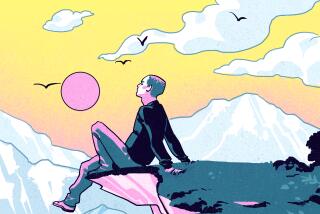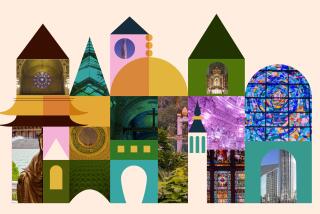Broad Range of U.S. Buddhist Leaders Endorse Project at Buddha’s Birthplace
- Share via
An international project to develop visitors’ facilities at the traditional garden birthplace of the Buddha in Nepal has been endorsed in this country by a broad range of ethnic Buddhist community leaders.
The degree of unity may exceed the cooperation displayed during periodic U.S. visits of the Dalai Lama, the widely respected Tibetan monk whose culture was a bastion for preserving the heritage of the ancient religion. Most U.S. Buddhist centers have concentrated on helping their own ethnic communities in the past and have had little time for pan-Buddhist activities.
U.S. fund-raisers hope that the slow-starting campaign to raise $5 million by 1989 will get moving this spring during Buddha birthday celebrations. “Most of our time has been spent in organization and expanding the board of directors,” said a spokeswoman, Miriam T. Garrett, who is based in Boulder, Colo.
$40,000 Raised
Only $40,000 has been raised in the first year of the North American part of the fund-raising project, which would be designated to build the U Thant World Peace Center. The center would have a 420-seat auditorium for international religious and social meetings.
The suggestion to develop the Lumbini Garden, a remote pilgrimage site for the hardiest of the world’s 250 million Buddhists, is credited to U Thant of Burma. He was secretary general of the United Nations when he visited Nepal in 1967.
A U.N. committee commissioned Japanese architect Kenzo Tange to design a master plan, and the Nepalese government reportedly spent $12 million from 1970 to 1983 to provide roads, airport extension, flood control, water and electrical supplies. The government also planted more than 620,000 trees on the plain near the Himalayan foothills.
Plans call for restoration of the three-square-mile garden area whose focal point is the Ashoka Pillar erected in 249 B.C. by the Buddhist Emperor Ashoka to mark the birthplace. A cultural center, facilities for visiting monks and administrative offices would also be built on another 25 square miles.
The story of the Buddha says that his mother, Queen Maya, stopped to rest at the garden when she gave birth. The Theravada schools of Buddhism, principally in South Asian countries, place the year of birth about 623 B.C.; whereas, the Mahayaha tradition and many non-Buddhist scholars favor a date circa 563 B.C. Siddhartha Gautama (the Buddha’s personal and clan names respectively) was said to have spent the early years of his life in luxury until encounters with the poor led him to seek a way to end cycles of human suffering.
Birthday Celebrations
Buddha’s birthday will be celebrated next month by South Asian traditions, which follow the lunar calendar. Japanese Buddhist congregations consider April 8 to be Buddha’s birthday and observed the occasion last Sunday. The seven-church Los Angeles Buddhist Church Federation is sponsoring am additional, public observance of Hanamatsuri, Buddha’s birthday, this Sunday afternoon in Little Tokyo. During the Sweet Tea Ceremony, tea is poured over a statue of the baby Buddha to symbolize a shower of sweet rain at his birth.
Little mention of the Lumbini project is expected at the Little Tokyo celebration, however, according to a minister familiar with plans for the observance. Although Bishop Seigen H. Yamaoka of San Francisco, head of the Buddhist Churches of America, and several other Japanese-heritage Buddhist leaders have joined the project’s board of directors, some Buddhist lay people have raised questions about possible political and economic motivations behind the Lumbini project.
“There has been some dissension about whether the birthplace is being commercialized,” said a Buddhist minister who did not want to be identified. “Some think it will destroy the spiritual nature of the pilgrimage.”
Garrett said the U.S. committee for the project is “sympathetic to the concerns” raised by some Buddhists. “And we’re not naive that the plan will further develop the country of Nepal,” she said.
Broad Membership Noted
But she pointed to the broad membership of the committee’s board of directors, which includes Buddhist leaders of Japanese, Korean, Chinese, Tibetan and Southeast Asian backgrounds. The board includes Venerable Taizan Maezumi Roshi of the Zen Center of Los Angeles and Venerable Phra Thepsopon, abbot of the Wat Thai Temple in North Hollywood.
Another supportive board member is Venerable Havanpola Ratanasara, a native of Sri Lanka who was recently elected to a fourth term as president of the Buddhist Sangha Council of Southern California. The council recently accepted the membership application of a Tibetan group, raising the membership to nine different ethnic Buddhist groups in Los Angeles.
Ratanasara said that despite some criticism of the Lumbini project, there is general support among Buddhists in America for the goals.
Ratanasara said he could not predict if the $5-million goal would be met by 1989. The fund-raisers are appealing for a minimum of $10 a year from individuals and $20 annually from families while using standard money-raising devices of designating heavier contributors as “major donors” ($500 or more) and “patrons” ($1,000 or more).
Although many Buddhists living in America are recent immigrants struggling for their own livelihood, Ratanasara said he believed that even they would give some money. “We all have high regard for the name of Buddha,” he said.
More to Read
Sign up for Essential California
The most important California stories and recommendations in your inbox every morning.
You may occasionally receive promotional content from the Los Angeles Times.













